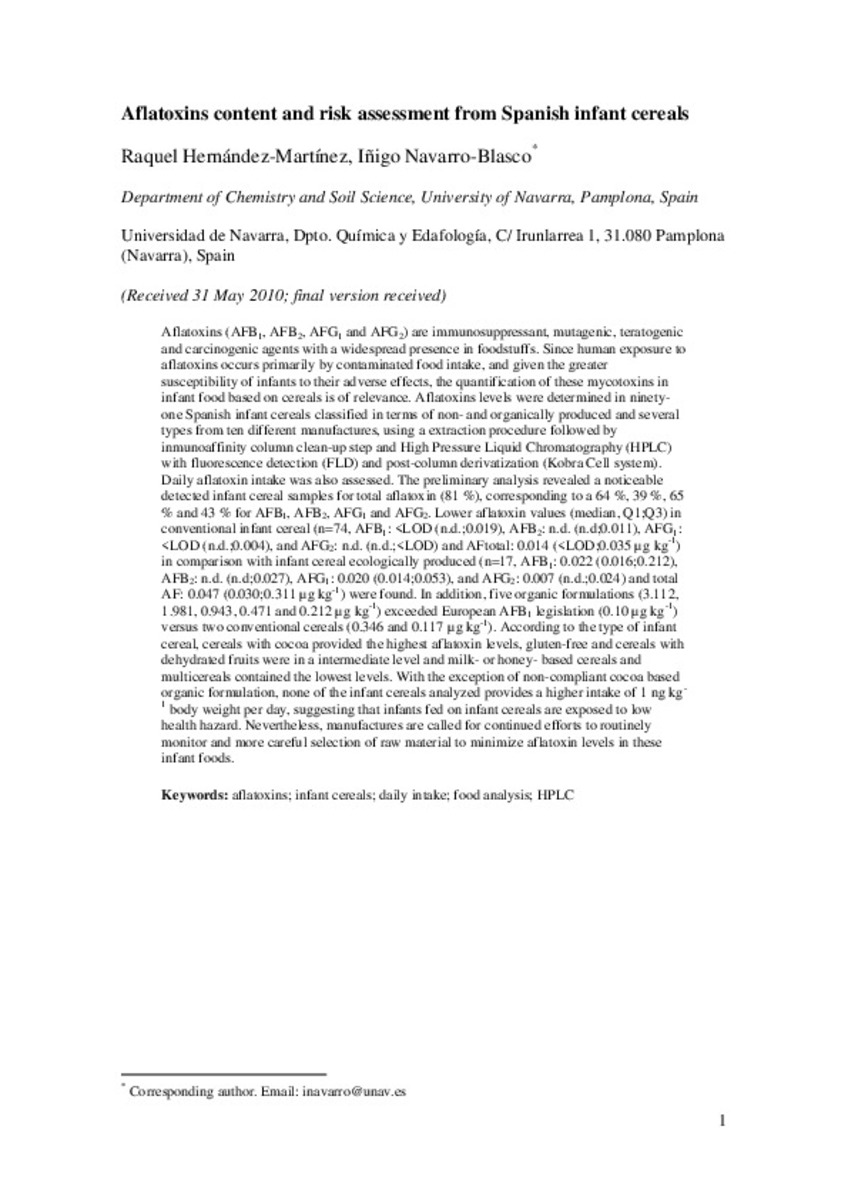Full metadata record
| DC Field | Value | Language |
|---|---|---|
| dc.creator | Navarro-Blasco, I. (Iñigo) | - |
| dc.creator | Raquel | - |
| dc.date.accessioned | 2018-01-12T08:39:51Z | - |
| dc.date.available | 2018-01-12T08:39:51Z | - |
| dc.date.issued | 2010 | - |
| dc.identifier.citation | Navarro-Blasco, I. (Íñigo); Hernandez-Martinez, R. (Raquel). "Aflatoxin levels and exposure assessment of Spanish infant cereals". Food Additives & Contaminants: Part B. 3-4, 2010, 275 - 288 | es_ES |
| dc.identifier.issn | 1939-3210 | - |
| dc.identifier.uri | https://hdl.handle.net/10171/45630 | - |
| dc.description.abstract | Aflatoxins (AFB1, AFB2, AFG1 and AFG2) are immunosuppressant, mutagenic, teratogenic and carcinogenic agents with a widespread presence in foodstuffs. Since human exposure to aflatoxins occurs primarily by contaminated food intake, and given the greater susceptibility of infants to their adverse effects, the quantification of these mycotoxins in infant food based on cereals is of relevance. Aflatoxins levels were determined in ninety- one Spanish infant cereals classified in terms of non- and organically produced and several types from ten different manufactures, using a extraction procedure followed by inmunoaffinity column clean-up step and High Pressure Liquid Chromatography (HPLC) with fluorescence detection (FLD) and post-column derivatization (Kobra Cell system). Daily aflatoxin intake was also assessed. The preliminary analysis revealed a noticeable detected infant cereal samples for total aflatoxin (81 %), corresponding to a 64 %, 39 %, 65 % and 43 % for AFB1, AFB2, AFG1 and AFG2. Lower aflatoxin values (median, Q1;Q3) in conventional infant cereal (n=74, AFB1: <LOD (n.d.;0.019), AFB2: n.d. (n.d;0.011), AFG1: <LOD (n.d.;0.004), and AFG2: n.d. (n.d.;<LOD) and AFtotal: 0.014 (<LOD;0.035 μg kg-1) in comparison with infant cereal ecologically produced (n=17, AFB1: 0.022 (0.016;0.212), AFB2: n.d. (n.d;0.027), AFG1: 0.020 (0.014;0.053), and AFG2: 0.007 (n.d.;0.024) and total AF: 0.047 (0.030;0.311 μg kg-1) were found. In addition, five organic formulations (3.112, 1.981, 0.943, 0.471 and 0.212 μg kg-1) exceeded European AFB1 legislation (0.10 μg kg-1) versus two conventional cereals (0.346 and 0.117 μg kg-1). According to the type of infant cereal, cereals with cocoa provided the highest aflatoxin levels, gluten-free and cereals with dehydrated fruits were in a intermediate level and milk- or honey- based cereals and multicereals contained the lowest levels. With the exception of non-compliant cocoa based organic formulation, none of the infant cereals analyzed provides a higher intake of 1 ng kg- 1 body weight per day, suggesting that infants fed on infant cereals are exposed to low health hazard. Nevertheless, manufactures are called for continued efforts to routinely monitor and more careful selection of raw material to minimize aflatoxin levels in these infant foods. | es_ES |
| dc.language.iso | eng | es_ES |
| dc.rights | info:eu-repo/semantics/openAccess | es_ES |
| dc.subject | Aflatoxins | es_ES |
| dc.subject | Infant cereals | es_ES |
| dc.subject | Daily intake | es_ES |
| dc.subject | Food analysis | es_ES |
| dc.subject | HPLC | es_ES |
| dc.subject | Materias Investigacion::Ciencias de la Salud::Química médica | es_ES |
| dc.title | Aflatoxin levels and exposure assessment of Spanish infant cereals | es_ES |
| dc.type | info:eu-repo/semantics/article | es_ES |
| dc.identifier.doi | 10.1080/19393210.2010.531402 | - |
Files in This Item:
Statistics and impact
Items in Dadun are protected by copyright, with all rights reserved, unless otherwise indicated.






